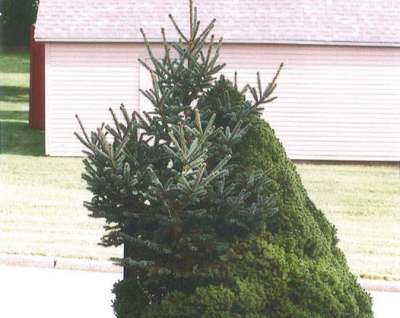Let’s begin with the original lower tree, which appears to be one of several similar-looking dwarf cultivars of white spruce. These are very common in the nursery trade, prized for their slow growth and highly symmetrical, densely compact form. This is a far cry from a typical white spruce, to be sure. And to understand why such a distinctive cultivar would appear to have yet another, entirely different-looking tree growing from it, we need to first know how the dwarf cultivar came to be.
Many such cultivars originated when some keen woods-walking observer noticed a “witch’s broom” in a spruce tree. This is a general term for a dense proliferation of stems and foliage originating from a single point on a stem or branch. These witch’s brooms, or “sports” as they are also called, have a distorted growth pattern that can look like a big squirrel’s nest or a dense shrub growing among the host tree’s branches. A variety of different agents can induce the formation of witch’s brooms in trees, but in northeastern spruces they are most often caused by rust fungi, such as spruce broom rust, or by parasitic plants, such as eastern dwarf mistletoe. Rusts are very hard on the host plant, reducing growth and leading to dieback, and mistletoes – despite their cheerful Christmas connotations – are ultimately a kiss of death to the host tree.
But witch’s brooms can also be caused by a genetic mutation within a single bud, which then grows into a shoot with a genetic makeup – and growth form – different from the rest of the tree. Such genetic brooms are less common than disease-induced brooms, but are also more likely to succeed. That is, if a particular witch’s broom is caused by a genetic change, it may not lead to the tree’s demise, and cuttings can be taken from it and grafted onto rootstocks. If it reproduces true to form, a cultivar is born. Indeed, this is how many dwarf spruces are propagated for sale as ornamentals.
So what gives with this tree? There it was, living its dwarfish life as intended by its horticulturist creator, who capitalized on an odd genetic fluke to create this unusual, slow-growing form. Then along came this new, odd offshoot of growth that looks nothing like the cultivar. It is not stunted, or particularly dense, or conical. It looks more like a regular white spruce tree.
Could it really be another tree growing in your dwarf spruce? In a way, yes, it could be. But not because a spruce seed landed and germinated there. Rather, it is genetically separate.
This “other tree” growing in the dwarf spruce cultivar is known as a genetic reversion. This branch on the cultivar has reverted back to the genetics and appearance of its parents. Just as a genetic mutation created the original witch’s broom from whence the dwarf cultivar came, sometimes a reverse mutation can occur and portions of the plant then revert to the original species’ form. As it happens, this is common in dwarf spruce cultivars. For unknown reasons, a bud will revert and the normal white spruce growth rate and shape will emerge in the new shoot, contrasting with the stunted form and growth of the rest of the cultivar. It sticks out like a whole new tree.
As seen here, the reverted portion will generally be more vigorous than the rest of the plant and, if allowed to remain, the reversion will eventually outgrow and overtake the cultivar. If you want to maintain the cultivar’s original form, you should prune out the reverted portion – back to a portion of the plant displaying the characteristics of the cultivar – before the reversion gets so big as to leave a gaping hole when you do remove it.
Or, just enjoy the bizarre look of your double-tree spruce and marvel at how the original form managed to outwit the horticulturist.


